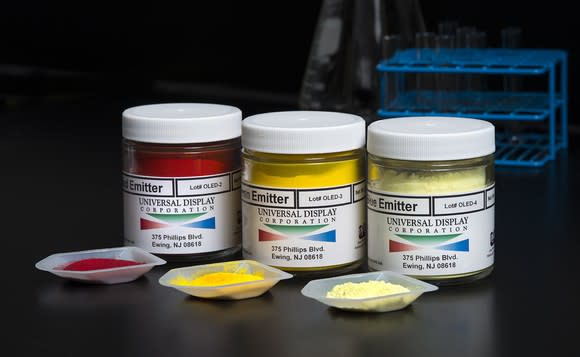Universal Display Falls on "Weak" Guidance
Universal Display Corporation (NASDAQ: OLED) announced strong fourth-quarter 2017 results on Thursday after the market closed, highlighting its central role enabling a slew of new electronics featuring its organic light emitting diode (OLED) technology.
But the OLED specialist followed with seemingly disappointing guidance for the coming year, and its shares plunged nearly 16% on Friday in response. Let's take a closer look, then, at how Universal Display finished off the year, and whether investors should be concerned over that light outlook.

Image source: Universal Display.
Universal Display's results: The raw numbers
Metric | Q4 2017 | Q4 2016 | Year-Over-Year Growth |
|---|---|---|---|
Revenue | $115.9 million | $74.6 million | 55% |
Net income (loss) | $32.8 million | $25.8 million | 27.1% |
Earnings per share | $0.69 | $0.55 | 25.5% |
Data source: Universal Display Corporation.
What happened with Universal Display this quarter?
These results brought Universal Display's full-year revenue to $335.6 million -- well above guidance provided last quarter for $310 million to $320 million.
Note GAAP net income included an $11.5 million tax expense related to the implementation of the Tax Cuts and Jobs Act of 2017 in December. Excluding that item, net income was $44.3 million, or $0.93 per diluted share.
OLED material sales increased 105% year over year to $59.8 million.
Royalty and license fees grew 23% to $53.8 million, including the second of this year's two $45 million license payments from Samsung Display.
Contract research services revenue increased 27.7% to $2.3 million, primarily driven by UDC subsidiary and contract research organization Adesis.
In December, the company signed a long-term license and material supply agreement with BOE Technology Group, China's largest display maker. It did not disclose exact financial terms or the duration of the agreement.
Last week, the company signed a new long-term agreement with Samsung Display, which is valid through the end of 2022 with the option of being extended for two years. Exact financial terms weren't disclosed.
OLED signed evaluation agreements with Royole Corporation, Sharp Corporation, and Govisionox Optoelectronics.
In late October, OLED completed a $15 million investment in PPG's Barberton, Ohio, manufacturing facility, doubling its commercial production capacity for Universal Display's phosphorescent emitters.
The company ended the quarter with $420.3 million in cash, cash equivalents, and short-term investments.
OLED doubled its quarterly dividend to $0.06 per share.
What management had to say
Universal Display CFO Sidney Rosenblatt stated:
From record-high revenues, to a multitude of new agreements and new OLED consumer electronic products, to approximately doubling our production capabilities at PPG Industries, 2017 was filled with tremendous growth. The dynamic OLED market is growing, and as a key innovation partner to the world's leading OLED display and lighting manufacturers, we believe that we are well-positioned to participate in the vast opportunities ahead.
During the subsequent conference call, management also revealed that they believe roughly $15 million to $20 million in phosphorescent emitter material purchases were pulled forward to the fourth quarter from the first quarter of 2018, likely driven by customers' inventory building efforts. So while revenue still would have arrived near the high end of expectations without those sales, Universal Display's fourth-quarter outperformance essentially came at the expense of its early 2018 sales.
Looking forward
To be clear, whether some revenue arrives a quarter early shouldn't matter to long-term investors; this is a zero-sum game that's still in its early stages. But in the meantime, Universal Display expects full-year 2018 revenue in the range of $350 million to $380 million -- below consensus estimates predicting 2018 revenue of $398.2 million.
"After an extraordinary year and a half of new capacity installs," explained Rosenblatt, "we expect industry capacity growth to take a bit of a breather this year, as panel makers build the framework for the next wave of high-volume OLED production, which is expected to ramp next year. 2019 is poised to be a meaningful year of growth."
More specifically, Universal Display believes that -- based on known production timelines -- the installed capacity base for OLED display manufacturing equipment will increase roughly 50% over the next two years as measured in square meters.
In the end, however, our short-term oriented market doesn't like being told to hurry up and wait. And with Universal Display shares still up more than 60% over the past year as of this writing, it's no surprise to see the stock taking a breather.
More From The Motley Fool
Steve Symington owns shares of Universal Display. The Motley Fool owns shares of and recommends Universal Display. The Motley Fool has a disclosure policy.
